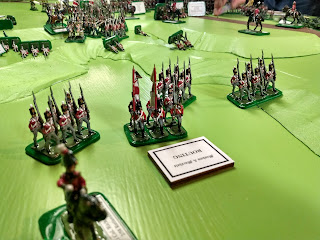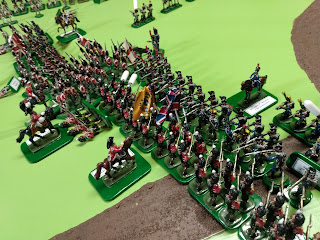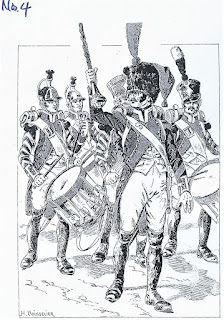After taking over ownership of the Tennant collection and starting in on the repairs and re-basing, I thought it would be fun to recreate the early Peninsular War battles using the figures. Little did I know what an all-encompassing and time intensive endeavor that would be! The initial online battle was Rolica, fought with Wellington Man of New Zealand using a turn by turn passing of orders and each of us rolling for outcomes and fire results while half a world away. Almost a full year and a half later I am finally knocking on the door of readiness for the subsequent battle of Vimiero.
The year is 1808. The French have fought a successful delaying action at Rolica, but were nonetheless, resoundingly defeated in the field of battle by the aggressive tactics of the British and Portuguese forces under the command of Wellington. Their sacrifice did however buy enough time for the French forces to combine and converge on the small town of Vimiero, where Wellington lay camped and hopefully (if you are French) unsuspecting of the rapid approach of the French army...
 |
Vimiero was essentially two battles; the battle for the town, and the battle several miles to the North.
|
 |
The northern battle was fought on gently rolling hillsides separated by deep ravines
|
 |
When scaled to the footprint of the miniature battalions, my wargames table is ~ 1.1 x 0.6 miles, which corresponds to the area of the battle shown above, and centered on the small farm of Ventosa.
|
 |
Construction of the hillside begins with 1/2 inch thick blue insulation foam.
|
 |
A hot wire foam cutter that I got at half price from the local art store long ago makes short work of trimming the edges, but open garage doors are a must!
|
 |
Frequent reference checks are required. The final map is marked with a grid to make the transfer of the hillside shapes reasonably accurate.
|
 |
Getting there. The magnifier is essential for reading the contour map!
|
 |
Still had plenty of left over paint from building the Rolica terrain.
|
 |
The hillside assembled with roads and rivers added to the ravines.
|
 |
The main road along the ridge was just painted onto the hills with a thick textured paint made from white glue, sand, water and brown paints. At this point the battlefield is essentially done and just awaiting the arrival of the troops!
|
Works in Progress
In the meantime I have been working on a variety of different modeling projects that have piqued my interest over the last month.
 |
After painting the Legion du Midi, I really wanted to paint some figures with well sculpted figures. The Franznap Bavarian foot artillery is an amazing set with beautifully sculpted figures and details. Here you see the artillery and limber almost done.
|
 |
The limber will be pulled by a six horse team.
|
 |
I realized I need another light infantry Colonel for the Vimiero battle, so here he is coming along.
|
 |
The Bavarian artillerists
|
 |
One of the 54mm sculpts from a friend's dad's collection. I'll be priming the whole piece white shortly now that construction is done. Getting the light foil of the reins to behave is proving to be a challenge however.
|
 |
Some guard Chasseurs a Cheval from that collection. These were quite the challenge to assemble, but if I can ever find the time to paint them will hopefully look truly impressive!
|
 |
I was inspired to add a bridge to my collection of terrain when I saw a post by Wellington Man featuring a river crossing, so I pulled out the Linka castings I had on hand. My son had cast up a ton of these from dental plaster, and I had just enough of the required pieces to pull this out of my hat.
|
 |
The bridge before adding a dilute plaster wash to smooth the joints and the placement of the end pillars.
|
 |
The diluted plaster really does an amazing job at disguising the seams, but I still wanted to texture the roadway pretty heavily to further hide the joints.
|
 |
The final piece. The variegated stone colours add visual interest as well as functions to disguise the seams. This was a super fun and quick project that really only took a couple of afternoons since all of the pieces were pre-cast.
|
I hope you have enjoyed this rambling post. The next post I had hoped would be all about Vimiero, but alas, I miscounted and need to prepare one more British battalion. The 23rd Welsh Fusiliers are prepped and should be a relatively quick addition as I am only adding a few command pieces. Until then, stay safe and happy gaming.


































































